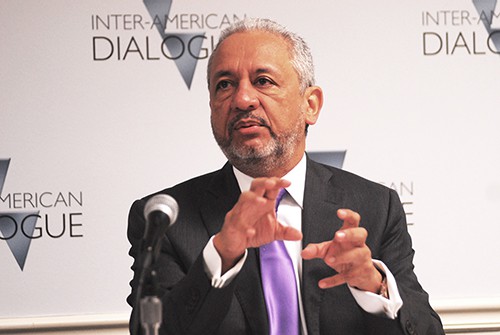WASHINGTON, D.C. — In the United States, electricity costs 10¢ to 12¢ per kilowatt-hour (kwh), while in Costa Rica, it’s 15¢ per kwh and considerably higher in Honduras and Nicaragua, Central America’s poorest countries.
Yet a top State Department official said the region — which relies heavily on diesel and fuel oil for power generation — is now in an ideal position to cut costs by introducing alternative sources like natural gas and renewable energy.
“Things that five years ago were not even possible are available today. Some methods of transporting containerized natural gas have come down in cost considerably,” said Robin Dunnigan, deputy U.S. assistant secretary for energy diplomacy.
Dunnigan said the Central American Electrical Interconnection System (SIEPAC) already links 37 million people in Panama, Costa Rica, Honduras, Nicaragua, El Salvador and Guatemala.
SIEPAC, which has been discussed since 1987, includes a 1,790-kilometer, 230-kV transmission line as well as improvements to existing systems. It cost $320 million without proposed interconnections with Mexico, Belize and Panama.
“The interconnection treaty between the United States and Canada took 30 years to negotiate. SIEPAC involves eight countries if you include Colombia and Mexico,” she said. “Over the last two years, they’ve tripled electricity trade and it’s already made a difference but more needs to be done: increasing capacity, resolving technical disruptions and oscillations, further refining the regulatory structure and finally connecting to Mexico and Colombia. We’re confident that the countries have the political will to get it done.”
Dunnigan was one of four officials who spoke May 7 at an Inter-American Dialogue conference. Some 150 people attended the panel, “Energy in Central America and the Caribbean,” including Román Macaya — Costa Rica’s ambassador to the United States — and representatives from the Washington embassies of Austria, Brazil, Canada, Colombia, El Salvador, Guatemala, Jamaica, Mexico, Netherlands, Panama, Spain, Trinidad & Tobago and Venezuela.
The event took place a month after President Obama’s visit to Jamaica, where he offered $20 million to finance private investment in Caribbean clean energy projects.
In late 2014, the White House launched the Caribbean Energy Security Initiative, an alternative to Venezuela’s Petrocaribe program under which the Washington-based Overseas Private Investment Corporation (OPIC) dedicates resources to facilitate deals in the Caribbean that match U.S. government financing with energy projects.
“A strategic project has finally come to fruition: the interconnected system among the five countries from Panama to Guatemala,” said Ramón Espinasa, lead oil and gas specialist at the Inter-American Development Bank (IDB), which has committed $150 million to SIEPAC. “The final link was closed late last year. The exchange of electricity has grown exponentially, particularly from Guatemala south.”
Espinasa, who was chief economist at Venezuelan state oil monopoly PDVSA from 1992 to 1999, noted that Mexico is already selling electricity to Guatemala — but that the transmission line is not connected to SIEPAC.
Natural gas is an ideal option, he said, but the nations of Central America are not heavily gasified at this point. “There have to be generators that can run on gas. Pipelines have to be built, and ports have to be deep enough to accept LNG tankers,” he said.
The cost of an LNG terminal has dropped from $1 billion to around $300 million. For the Caribbean, he said, compressed natural gas shipped from Florida could be sent as far south as Jamaica — about 1,000 nautical miles.
Michael Cummings is the special adviser for climate and renewables at OPIC, which offers loans, political risk insurance and debt support for private equity.
“One thing that distinguishes us is that we can only lend to private-sector entities,” he said. “We’ve been very active in renewables and have loaned roughly $1 billion a year worldwide in each of the last four years to wind, geothermal and biomass projects.”
But the main barrier to expanding energy infrastructure in Central America and the Caribbean is the lack of bankable projects. To address that, Cummings said, OPIC is partnering with the U.S. Agency for International Development (USAID) to provide developers with project assistance, feasibility studies and legal document preparation.
“We are interested in natural gas projects,” he said. “We just don’t have any in our pipeline in the region. We need developers to bring us projects.”
Ricuarte Vásquez, the Panama-based CEO of General Electric Central America and the Caribbean, said Central America’s institutional setting is complicated, because Panama and Guatemala have a private energy market, while in Costa Rica it’s fully state-owned, with little private participation.
See also: The battle over distributed generation of electricity in Costa Rica
“In the Caribbean, it’s very complex,” he said. “In the English-speaking countries, it’s usually more state-oriented, and even if they have private institutions, the market prices do not reflect the cost of energy, and that makes it very challenging to put a project together, because it’s heavily subsidized for political reasons. That leads to a vicious cycle of indebtedness to keep prices low.”
Another issue is theft, said Vásquez, who was Panama’s finance minister twice. In the Dominican Republic, for instance, about 35 percent of the electricity produced is stolen, he said — and in some cases, the theft takes place at the institutional level.
“In spite of the difficulties, we are looking for solutions. The demand for energy is there,” he said. “Gas could be a solution, but it’s a long-term solution. Nicaragua has huge potential for geothermal, but research happens to be expensive. However, once you hit it, it’s a very clean solution.”
Related: Costa Rica opens the door to more renewable energy generation






